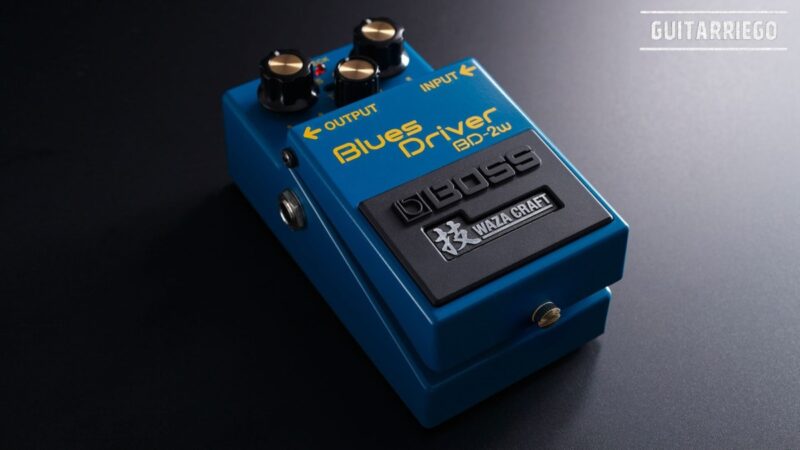What mahogany-type woods do cheap Les Paul guitars have?
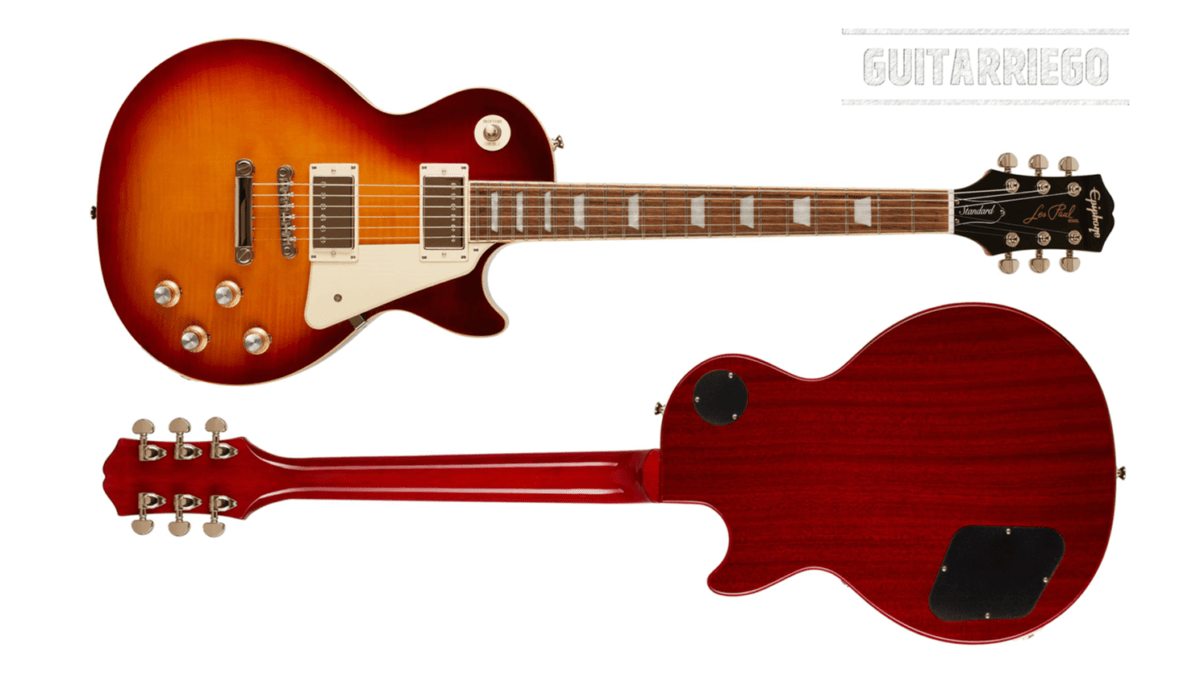
Epiphone, Cort, Samick, Ibanez, SX and many other cheap guitar brands produce Les Paul type guitars, we’ll tell you what mahogany substitute woods they use.
Are cheap Les Paul guitars made of Mahogany?
In the specifications of inexpensive Epiphone Les Paul Standard and other similar guitars, we often find the name mahogany, but are they really built with that “Tonewood”? As you can imagine, this is not true. A clear example is the same Epiphone that publishes on their website that their Les Paul guitars are constructed from mahogany when in fact they use other substitute woods.
To understand a bit, let’s take a look at what real mahogany is and what other woods, due to their similarity, are commercially referred to as mahogany when they really are not.
Honduran or Genuine Mahogany
The Honduran Mahogany or Genuine Mahogany (Swietenia macrophylla) used by Gibson for their guitars such as the Les Paul and SG, is a tree that grows in Central and South America. At one time, Honduras was the main exporter, hence its name. This species also grows in countries like Mexico, Belize, Nicaragua, Colombia, Peru, Bolivia, Brazil, etc.

Mahogany can also be called mara. Thus, the Mara Boliviana is the same tree (Swietenia macrophylla) that grows in Bolivia.
Other Mahogany Species: Native and Pacific
In addition to the Genuine or Honduran mahogany, there are two other species of Mahogany. One is Native Mahogany and the other is Pacific Coast Mahogany. These two species are not exploited commercially, at least for the construction of guitars. Thus, Honduran mahogany is the only genuine mahogany used for the construction of guitars.
The native mahogany or also called West Indian or Cuban Mahogany (Swietenia mahagoni) grows in southern Florida and in the Caribbean. Until the Second World War, it was the most commercialized mahogany species, but today its commercialization is very limited. The other species is the Pacific Coast Mahogany (Swietenia humilis), a small, sometimes crooked tree that grows in the dry forest of the Pacific coast of Central America. It is a species of limited commercial utility. Thus, the only species traded is Swietenia macrophylla, that is to say the Genuine or Honduran Mahogany.
These three mahogany trees belong to the Meliaceae family. Although there are no other mahogany trees, commercially other species from Africa, Asia and Oceania are also referred to as mahogany.
Mahogany substitute woods
As we have seen, only genuine or Honduran mahogany is the only true mahogany used for guitars. However, there are other woods that are commercially referred to as “mahogany” because of their aesthetic similarity.
African Mahogany or Khaya and Sapele Mahogany or Sapele
Also, known as samanguila, Khaya or African mahogany and Sapele or Sapeli (Entandrophragma), are woods of the Meliaceae family, which originated in Africa and are commercially referred to as mahogany. They are native to the tropics of Africa and Madagascar. Although they are not real mahogany, they do a good job of replacing their reddish appearance and grain shape.
Although Khaya is referred to as African mahogany, the latter term is often confused with sapele. So, you will see that many times the sapele or sapele is also called African mahogany. These two species, besides having an aesthetic similarity, are also characterized by a very similar tone, although they are heavier than mahogany. These woods are probably the most similar and the best substitute for mahogany. In fact, it is used in high quality instruments such as the Ibanez Artstar AS2000 made in Japan.

Khaya is the cheaper of the two, but it is more difficult to work with. Sapele, or sapele, is much easier to work with, almost as much as real mahogany. For this reason, sapele mahogany is more expensive than African mahogany or Khaya, but less expensive than Honduran mahogany. Taylor uses Sapele for the sides and backs of their cheaper acoustic guitars.
One characteristic shared by the three mahogany named so far: Honduran Mahogany, African Mahogany and Sapele Mahogany is that all of them just cut have an underwhelming pale color. But after two weeks they take on that beautiful reddish color that makes it so precious.
Asian mahogany and others
Among the species commercially identified as mahogany there are many other woods, the list is almost endless. But we will focus on those used in the musical instrument industry.
Philippine Mahogany
In this Philippine mahogany name, you can find members of the genus Shorea such as Meranti or Lauan, from the Dipterocarpaceae family, which are used for building guitars. In some US forums, they claim that Epiphone Les Paul guitars use this wood.

Palaquium (Nyatoh) and Mora (Nato)
Other aesthetically similar woods with excellent tonal properties are Palaquium -Nyatoh- and Nato -Mora-, which are used as Tonewoods by Asian guitar makers with excellent results.
Many times confused with each other, and sometimes they even treat them as if they were the same wood. These two species are widely used in the making of instruments and also as a substitute for mahogany. Although, as we said before, they have no relationship with Mahogany. Both woods are used for their timbral qualities in medium quality instruments. The reddish Nyatoh is used in Ibanez instruments. For example, the Ibanez Artcore AS153 and Cort CR line are made with Nyatoh.
Mora or Nato wood is also a very good replacement for Mahogany. Takamine uses it for the back and sides of some of his acoustic guitar models. On its website, Takamine states: “Often referred to as ‘Eastern Mahogany’, Nato is a species which offers similar looks and similar characteristics to regular mahogany. It offers a cost effective way to build a guitar with great looks and great tonal output.”
Others woods: Okoume and Basswood
Finally, it should be noted other woods, which although not commercially referred to as “mahogany”, are used as a substitute for this. Among them we find Basswood, also used as a substitute for alder because of its good response in the middle frequencies. Also the Okoume, widely used for cheaper Epiphone and Ibanez guitars, although its tone is far from that of mahogany because it does not stand out for its midrange frequencies.
Levels and qualities of mahogany substitutes for guitars
The list of mahogany substitutes or substitutes is very long. However, there are some that stand out and do their jobs very well like Tonewood. Thus, we can group the substitute woods of mahogany into different quality levels.
Among all the woods named, we can give an orientation of qualities. The higher level substitute is Mahogany Sapele or Sapeli, with a similar appearance and tone, and more easily manageable than Khaya, the latter following. Then we will have the Nato or Eastern Mahogany, used by Takamine in its most affordable acoustics. Finally, we have the Nyatoh. All of these woods are used by brands such as Epiphone, Fender, Ibanez, Taylor, Takamine, Cort, among others.
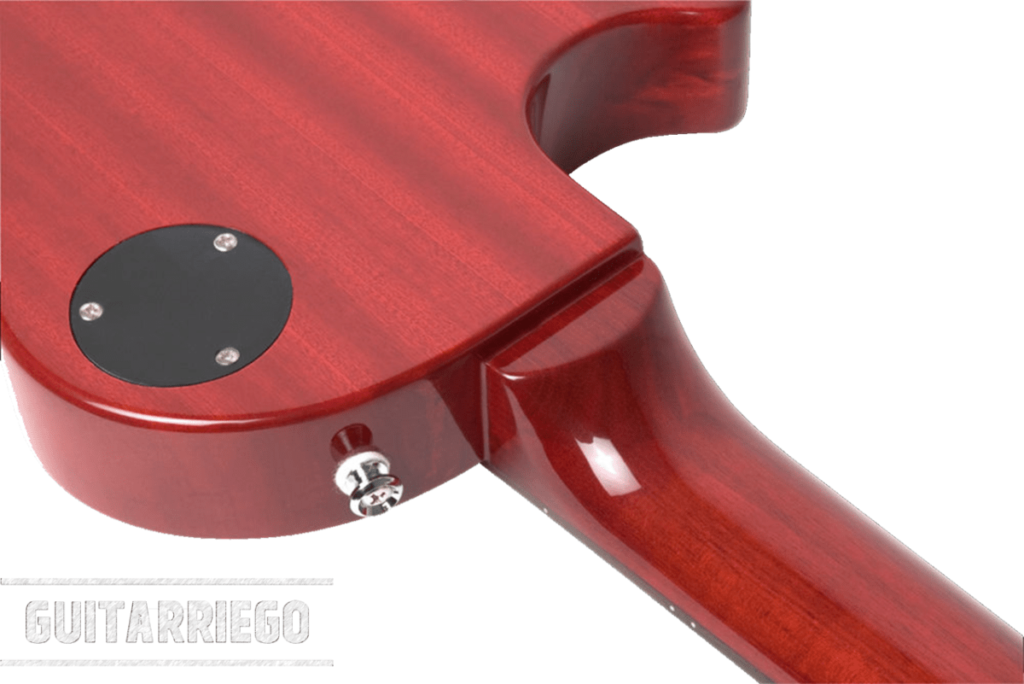
What wood does each brand of guitar use?
As we have seen, none of the cheap low-end or mid-range Les Paul type guitars or other Gibson guitars like the SG actually use real mahogany, that is the Honduran mahogany. Instead, they use surrogates, let’s see which ones use brands like Epiphone, Ibanez, Samick and others.
What mahogany replacement wood does the Epiphone Les Paul Standard have?
It should be noted that Gibson is not very transparent regarding to the woods used by Epiphone. Currently, Epiphone reports that it uses different woods depending on the guitar model. For less expensive models, it indicates that it uses okoume, while for more expensive models like the Les Paul Standard, it indicates that it uses “mahogany”. We don’t really know which of all the pseudo mahogany Epiphone uses. Gibson does not give this information.
So we can find examples, such as the Epiphone Les Paul Express Epiphone (USD 149) has okoume neck and “mahogany” body, the latter must surely be African or Philippine mahogany. In contrast, the Les Paul Standard 1959 model is entirely in African or Philippine mahogany.
Let’s continue our analysis on the supposed mahogany from which the high-end models of Epiphone are built. Also consider that Epiphone typically uses veneers on the back of the body to simulate a single piece of wood. These wood veneers show a pattern very similar to African striped mahogany like Khaya and Sapele and Philippine mahogany Meranti, also known as Lauan. But, it can also happen that the veneer used is made of a different wood from that of the body. For this reason, we looked for bodies in which the different parts could be distinguished, to ensure that the visible wood is real wood. When we see these bodies, we see that they don’t have that stripe pattern marked in the grain.
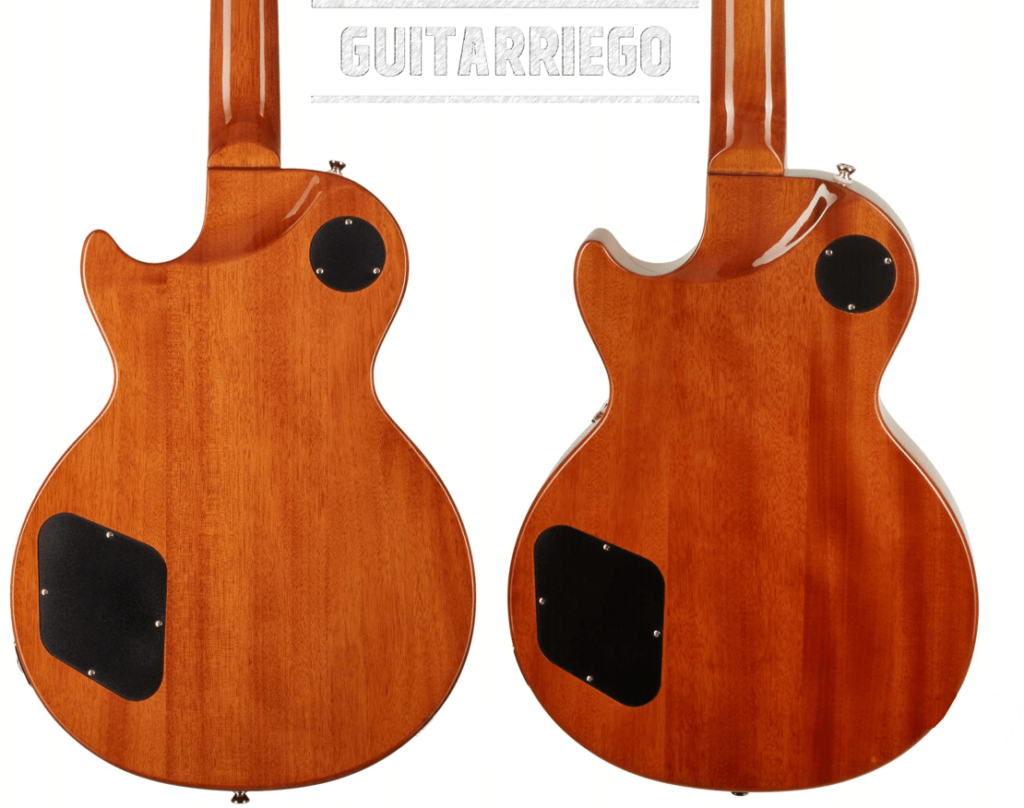
Thus, it is not really possible to confirm for sure which mahogany substitute is used by Epiphone. Nor if they use only one type of wood, or if they use according to availability, plant or model. In some forums it is read that Epi is probably using Meranti or Lauan, which as we have said is also known commercially as Philippine Mahogany. The latter seems more than reasonable given the price level managed by the brand.
What mahogany replacement wood do Ibanez guitars use?
Ibanez is one of the more transparent companies with Cort on the woods used in their guitars. On its website, it generally provides clear information about the woods used in its instruments. Looking at their product catalog, you can see that they use Alamo and Okoume to replace mahogany in low-end, cheap guitar bodies.
For medium lines Ibanez uses Nyatoh, while for higher ranges made in Japan they use African mahogany, but it is not clear whether it is Khaya or Sapele. But, the Khaya is generally called so.
What woods does Cort use in his CR Les Paul line of guitars?
Cort uses poplar as a mahogany substitute for the body of the CR50. While for the rest of the models: CR100, CR150, CR200, CR250 and CR300, Cort reports that he uses Palaquium also known as Nyatoh.

What wood does Gretsch mahogany replace in your budget range?
Until recently, Gretsch used basswood as a mahogany substitute for the Pro Jet bodies in their Chinese range. This model, an Asian version of the Duo Jet, came with a basswood body instead of mahogany. The mahogany neck of the Duo Jet is replaced by a maple neck on the Chinese Pro Jet.
This year, Gretsch released a new Asian version of the Duo Jet called the Double Jet, this new budget version brings in a mahogany body and neck. So, like Epiphone and PRS, Gretsch does not report which cheaper mahogany replacement wood is using for its new Chinese guitars.

What mahogany substitute does PRS use for its SE Asian range?
Like Epiphone and Gretsch, PRS simply reports that they use “mahogany”. Thus, PRS does not clearly state which wood it uses in its cheapest range made in Indonesia, the SE -Student Edition-. However, given that the maker is Cort, and the Company uses Nyatoh (Palaquium) for his own guitars, we could infer, but not confirm, that Nyatoh is most likely the mahogany replacement that the PRS SE has.
What substitute for the Coaba do Vintage Les Paul guitars use?
Unfortunately, Vintage is another brand that doesn’t point out the mahogany substitute they use. Fortunately, one of their models, the Vintage V100MRPGM, is Relic and clearly shows the wood without paint. Therefore, we can see that it doesn’t appear to use African Mahogany, Sapele, or Meranti due to the lack of a striped pattern they typically exhibit. Instead, it seems to have a vein compatible with the Nyatoh, the same wood that used by Cort and Ibanez.
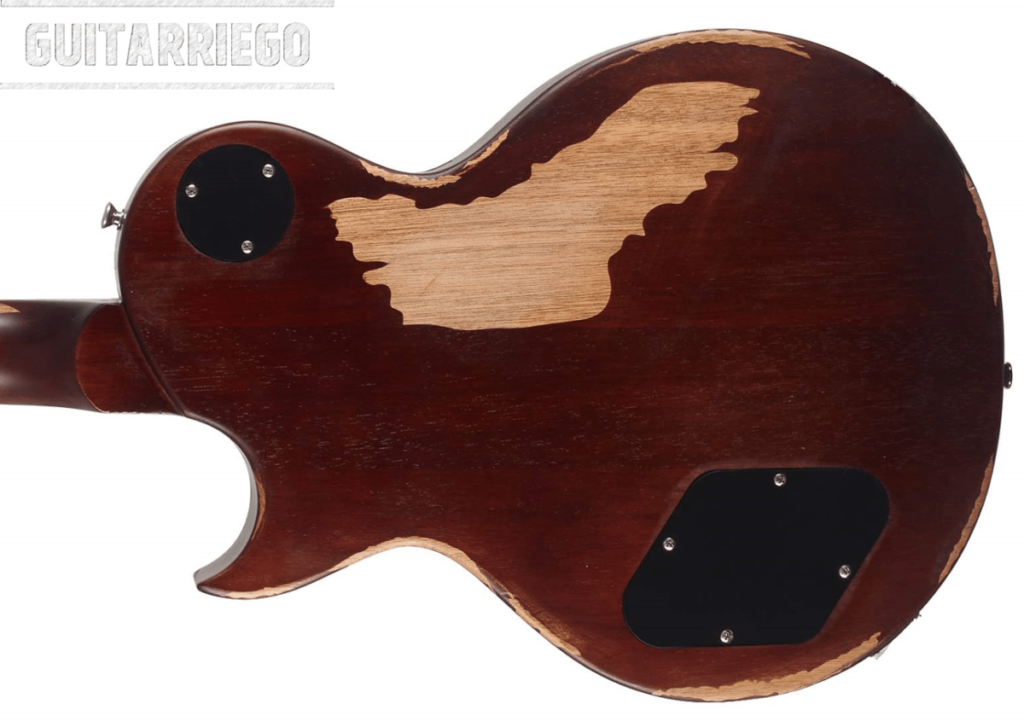
What wood does Samick use to replace mahogany?
Samick is one of the largest manufacturers in Asia. He has many years of experience in making instruments, both for himself and for others including Les Paul and SG. Thus, it is difficult to say precisely which woods he used in each of the years, and which models. Historically, Nato is a wood used a lot by Samick, but we can’t really confirm what wood they use.
The ear rules
We have seen that mahogany is an expensive wood from America and difficult to find outside of the highest quality guitars. There are some very good substitutes for genuine or Honduran mahogany, such as Sapele or Sapeli, also known as sapele mahogany, and khaya known as African mahogany. There is also the Nyatoh and the Nato, which work very well. However, the most important thing is not the wood, but that the guitar sounds good.
An instrument can sound good even if it is made of a non-traditional wood, and it can also happen that it sounds bad and has a classic tonewood. Therefore, the important thing is that you love it and not the wood in it.
That said, there are also differences in tone preferences and musical style. I was able to compare a Gibson Les Paul to a high end Epiphone with Gibson pickups. Playing with Drive, the differences were minimal, but in clean sound, the Gibson’s mahogany tone could be clearly differentiated from that of the Epiphone. So if you are playing with a clean tone, it may or may not matter whether it is real mahogany. But if your style is a more distorted tone, the differences will be very little audible.
Have you been able to compare some of all these woods, what differences have you heard between one and the other? Share your experience in the comments section.
Related remarks:
- Gibson Les Paul vs Epiphone Les Paul: Features and Differences.
- History of Epiphone guitars: secrets, myths and truths.






